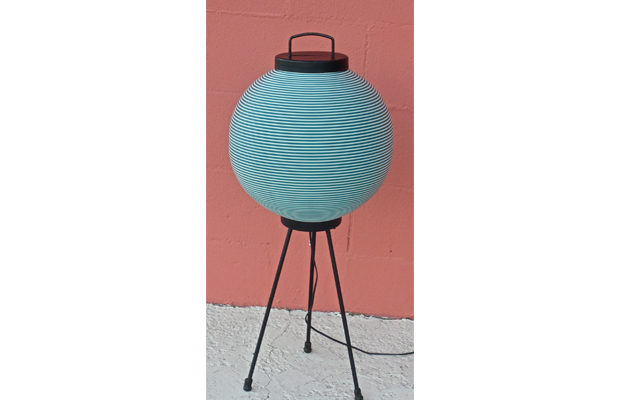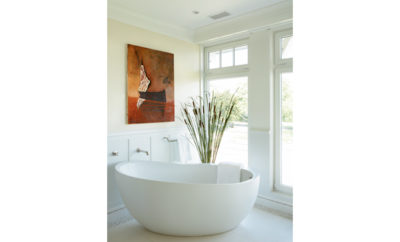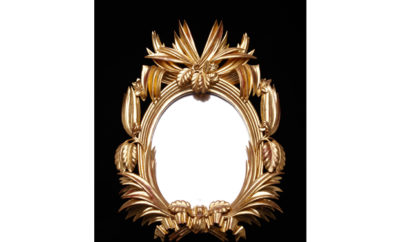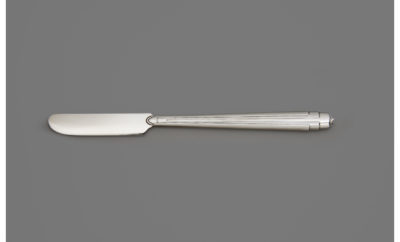
Feature
Shedding New Light

Under-recognized today, the Heifetz Manufacturing Company of New York produced some of the most striking and stylish lamps of the mid-twentieth century, several emerging from a contentious 1950 design competition.
Only a hard nosed man would have gone toe-to-toe with architect Marcel Breuer over design theory and application. Manufacturer and designer Yasha Heifetz was up to the task. In 1949 an unusual exhibition opened at the Museum of Modern Art in New York: it was a house designed and furnished by the eminent Bauhaus-trained Breuer, erected in the museum’s garden. Topped by one of Breuer’s signature shallow V-shaped “butterfly” roofs, the structure was meant to be a model home for the modern middle-class family. The exhibit attracted record crowds and drew wide press attention.
The decor had one quirk: it contained no lamps of any kind; all illumination would come from installed lighting fixtures. (The exhibition house was not electrified.) Breuer argued that he could not find a well-designed modern lamp, and suggested that lamps, in any case, were superfluous. “The light is more important than the lamp,” he is quoted as saying in the Wisconsin Rapids Daily Tribune of November 23, 1949. “Light is purely functional, and in this sense, the need for light is perhaps more functional than any other aspect of the interior.” Heifetz, proprietor of New York’s Heifetz Manufacturing Company, a firm that specialized in lamps, naturally took exception. In his opinion, nothing would ever replace the warmth and eye appeal of a good-looking table lamp. Built-in lighting was “flat and static,” he claimed in the San Rafael (California) Independent Journal of February 4, 1950. Then he set out to prove Breuer wrong.
By the time of the Breuer exhibit at MoMA, Heifetz had been in business for eleven years. His firm’s bread-and-butter was table lamps, though it also manufactured ashtrays, sculptural objects in wood or metal, and some furniture. Heifetz was a hands-on boss: of the approximately 4,000 pieces his company produced in its more than twenty-five-year run, Heifetz estimated that he himself had designed about half of them. He was a technical innovator, having developed new glazing methods for textured ceramic lamp bases, and he received several patents for furniture designs.
The most popular Heifetz lights were table lamps with abstract bases. These artistically styled lamps were typically made of ceramic, wood, brass, copper, or sheet metal. Bases often depicted stylized human figures, both male and female. Kidney and melon-shaped lamps were a Heifetz signature. He also made decorative sconces and pendant lights.
In cooperation with MoMA, in 1950 Heifetz cosponsored a national lamp design competition. His motive was not solely self-promotional. Given the attitudes of Breuer and other modernist purists, Heifetz felt the competition offered a platform from which to change perceptions about domestic lighting—a way to prove that it was possible to produce a functional and efficient lamp that was also decorative. The rules for submissions were simple: the light—whether a table or floor lamp—had to be portable, use an incandescent light bulb, and could not resemble an existing Heifetz light.
The response was overwhelming. MoMA reported that “more than 600 competitors from 43 states” entered the competition, submitting nearly 3,000 designs. In addition to Heifetz, Breuer, and others, the jury included the museum’s director René d’Harnoncourt, Philip Johnson, director of the museum’s architecture and design department, and lighting designer Richard Kelly. (The latter two were particularly suited to the job. That year they co-created one of the iconic modernist floor lamps, a piece intended for Johnson’s recently completed “Glass House.” The lamp, with its conical hood mounted over a cylindrical canister holding a light source, was originally conceived with three brass supporting legs, but a fourth was later added to provide more stability. The lamp was later produced by the Edison Price Company.)
Some of today’s better-known designers participated, including Richard Schultz, then a new arrival at Knoll, and Frank Greenhaus and Kevin Roche, both young architects at the time in Eero Saarinen’s office, who submitted a joint entry. The most inexpensive entry came from Alexey Brodovitch, art director for Harper’s Bazaar: a wooden tripod-based lamp with a shade on a stem that could be raised or lowered to provide brighter or dimmer light.
The prizes were announced in 1951, and ultimately fifteen designers received awards. As part of his sponsorship, Heifetz immediately put ten of the winning designs—eight table and two floor lamps—into production. Even Breuer, satisfied with the results, placed lamp orders for clients. The museum exhibited the group in its New Lamps exhibition of 1951. A dozen stores across the country sold the lamps during the run of the exhibition, including Carson Pirie Scott and Company in Chicago and Macy’s in New York, San Francisco, and Kansas City, Missouri. A traveling version of the exhibit also promoted sales in other areas.
Heifetz’s gambit proved to be a widely influential success. Modern lamps had won respect.
What are the chances that one person could have his most successful lighting designs misattributed to two internationally known figures, Frank Gehry and George Nelson? If you ask Gregory A. Van Pelt, the answer is: pretty good.
In 1976 Van Pelt, a onetime Chicago journalist, produced a line of cardboard lighting using a compass and razor blade. He called the pieces “Flute” lamps, and eventually devised some twelve models of table, floor, and pendant lamps. Van Pelt saw great potential for the material and did not consider cardboard furnishings a gimmick. He also looked at ways to improve his design and created a patented method for another type of cardboard lighting: a “sculptured lamp base,” which used a tightly wound, narrow cardboard strip to form a variety of shapes around a mold.
Unfortunately, his designs appeared not long after Gehry’s 1972 cardboard “Easy Edges” furniture. Gehry did not produce cardboard lighting, but perhaps the timing and material made the attribution to him unavoidable. The difference between Van Pelt’s fiberboard and Gehry’s laminated layers of cardboard may have been too subtle for initial buyers to notice. Like many misattributions, the error took on a life of its own. And a strong life, as well, as an Internet search proves.
Van Pelt’s other lighting design is misattributed to designer George Nelson. It is commonly referred to as the “Kite” lamp—an apt description since the shade resembles a box kite—though Van Pelt actually called it “Wireworks 1.” It was introduced shortly after the “Flute” lamps and five models were available: a shelf light, table lamp, pendant light, and two floor lamps. The bases were made of chrome, and buyers had a choice of twelve cotton fabrics, both solids and prints, for the shade. Both “Flute” lamps and “Wireworks 1” were sold in various department stores, including Carson Pirie Scott in Chicago, Bloomingdale’s, and Wickes Furniture Stores. The popular modernist distributor Raymor/Richards Morgenthau ensured that Van Pelt’s designs were widely available across the country.
It is unclear how or why the Nelson attribution gained circulation. Maybe it was a selling ploy by a dealer or collector, or simply a case of someone not knowing better. Van Pelt designed at a time when signing a piece or labeling it with one’s name was not the customary practice it is today. Perhaps misattribution, however it comes about, is an acknowledgment of the quality of a design. In other words, if a piece is good the assumption is that someone famous must have made it.












